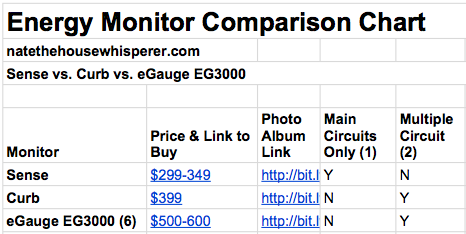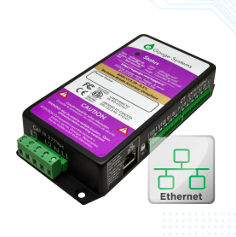|
If your electricity bills seem too high, and you aren't sure why, getting a home energy monitor could be a good way to figure it out. If you want to know if your usage is high, use our calculator that compares your home to others in your state based on Department of Energy data.
In our practice we've used three different energy monitoring systems. More importantly, we've used them all for over a year, so we understand their strengths and weaknesses. Two recent entries are the Curb and the Sense, which offer more modern looking apps than "older" electricity monitors like eGauge 3000 at the Hiram College Tree House project. (You can see what's happening at the Tree House live here.) Let's dive into the comparison of the three, here's my video comparison of the three energy monitors (which is more in depth than this article):
Full Disclosure: Curb sent me two of their monitors for free and paid to install them. I bought and installed Sense myself (they recommend having an electrician do it.) The eGauge 3000 was bought and installed by Hiram College, my role was in fixing the setup so it created useful data.
Energy Monitor Framework When comparing products with very different strengths and weaknesses, I find it's best to look for the attributes I care about. For power monitors here are 5 attributes I find useful. Next we'll dig into those 3.
Ease of Install There are two types of home electricity monitors, which one you choose basically determines install time:
Installing machine learning energy monitors is no big deal. If I did it every day, I bet I could do it in 15 minutes, my two installs each took about 25. While the manufacturers recommend having an electrician do it, for DIYers that aren't nervous around their electric boxes, it's not a big deal. (Be sure to turn the power off!) One bad part of machine learning energy monitors is that you never really know if a device will be monitored. Sense doesn't seem to pick up individual appliances under 30 watts. If you want to know when your cell phone charger is on, you're probably out of luck. Another bad part is that machine learning devices often confuse appliances. My Sense thinks that my coffee maker is my dishwasher, and vice versa. It also thinks my heat pump water heater is my dehumidifier, and vice versa. If two devices look similar, the Sense Labs device may get confused. Fair warning. Multiple circuit electricity usage monitors, on the other hand, will let you know if something is on, as long as you choose to monitor that circuit. It won't tell you what specific appliance is on, but you will likely be able to tell by how many watts it pulls. In the case of a dishwasher or refrigerator, which are supposed to have dedicated circuits, you will know for sure when they are running. A big downside to multiple circuit devices like Curb and eGauge is that they are a serious pain to install well. Every circuit in your house has to be labeled, and often they aren't. It took me over 2 hours to figure out the 40+ circuits in my house. In one install, the circuits were mislabeled, so after spending 4 hours carefully installing a Curb, I had to go back and totally change the configuration, which took me another 3 hours, plus the time it took to figure out what the correct circuits actually were. (I would get faster with time, but the 45 minutes that Curb mentions is unrealistic in anything other than ideal conditions.) Plan on installing multiple circuit monitors twice. Once with the best information you have, and again when you have a better handle on which circuit goes where. Since you are limited in how many circuits you can monitor, you'll likely change which circuits you monitor the second time if you see the "other" category with huge power usage. While the install time of multiple circuit devices may seem off-putting, with machine learning devices you will spend a fair amount of time figuring out which appliance is which. Sense will tell you that "Unknown Motor 6" just turned on, it's your job to figure out what that motor is. So machine learning devices can be heavy on after install work, where multiple circuit devices are a lot of work to set up. Is the Machine Learning type or the Multiple Circuit type better? It depends on what you need and your preferences are. If you absolutely, positively have to know what that big draw is, get a multiple circuit device. If you are ok with the potential that a machine learning device won't find some appliances, you want a quick install, and you don't mind a little detective work figuring out what "Unknown Motor 6" is, get a Sense or Neurio. App Quality The software really makes or breaks electricity usage monitors. Depending on your preference, you may want a web app, a mobile app, or both. The video does a far better job dealing with this than I can in words, so take a look at that section of the video. The last 3 attributes relate directly to the software/apps. The quick rundown is that Sense has hands down the best app, but it's a mobile app only and you can't export data from it. eGauge only has a web app, it's a bit old-school, but provides the best data download. Curb has mobile and web apps that function similarly, and is really good at charting usage by circuit. Odometer vs. Speedometer In your car, the odometer tells you how many miles you've driven, but not how fast you went to drive those miles. In a home energy monitor, this is how much energy you have used over time. Sense and Curb will tell you how much energy individual appliances/circuits used. Sense will tell you almost any time period you want, Curb only tells you week by week in their weekly "energy audit" email. In your car, the speedometer tells you how fast you are going at any given moment. In home energy monitors, they tell you how many watts you are using at any given moment, and also chart how many watts were being used at different points in time. All three tested monitors will tell you how many watts were being used at a certain moment by individual appliance or circuit. The Sense stands head an shoulders above the Curb and eGauge 3000 for odometer and speedometer functions, in my opinion. For the speedometer function, Sense lets you quickly zoom in and out on usage at any moment since the device was installed. eGauge lets you do it by setting the time parameter, but that's much slower. Curb has an awesome chart for which circuit was using how much power, but you can only choose time periods of 3 hour, 1 day, 1 week, 1 month, 1 year, and all. If you want to zoom into 3 hours yesterday you're out of luck. For the odometer function, Sense lets you look at the total usage of any day, week, or month. (See the app review video, it's pretty cool.) It also breaks it down by the appliances it has found. Curb is quite limited in that the only usage data over time comes from the weekly audit emails, hopefully that will change. Curb does break usage down by circuit in that email, though. eGauge has a pretty decent odometer function that lets you select any time period to look at usage, and by default shows you the last month of usage. It does not break down usage by circuit unless you export the data, which is our next topic. Data Export If you really want to crunch the numbers, you need to export data into a spreadsheet and go nuts. Personally, I don't really like manipulating spreadsheets with lots of data, I prefer visual representations of data to look for anomalies. eGauge wins this category hands down. You can export data from any period, and you get usage by circuit. It's awesome. Curb lets you export data for its set time periods (3 hours, 1 day, 1 week, 1 month, 1 year, and all.) Sense fails in this regard. There is no data export as I write this in October 2017. They plan to do it, though. It's up to you to decide if this is a big deal. Reverse Polarities This is a particularly sticky issue. CT clamps are very sensitive about how they are installed. If you put one on "upside down" it won't report that a circuit is using energy, it will report that it is generating energy. That's what I mean by reverse polarities. If you ever got your pluses and minuses backwards in math, you know that it makes your answers wrong. This only appears to be a problem with multiple circuit devices. If you put a CT clamp on backwards for Sense, the software compensates. For the multiple circuit monitors, it can ruin the usefulness of the data. At the Tree House, enough were reversed to essentially zero out the energy usage of the building. The eGauge said it had used 350 kilowatt hours (kWh) for a year, when reality was a little under 15,000. I've struggled with my Curb to get it accurate. Curb and eGauge both give you ways to reverse the polarities of the circuits, but it's an extra step. Curb made it more difficult to reverse polarities with a recent update, and now I have to classify circuits like they are generating electricity rather than using it to reverse them. It's less than ideal. Avoiding the reverse polarity problem is another reason I lean towards the Machine Learning variety unless you are an advanced user. Summing Up Having a year+ with each of these three home energy monitors has been really useful to understanding their strengths and weaknesses. Professionally, we use them to figure out if our assumptions and energy use predictions were accurate, and to find problems in client homes. As a homeowner, it's a step to finding out why your usage is so high. (You can use our calculator, which is based on Department of Energy Data, to see if your house is an energy hog or not.) You might also look at which months are highest to figure out what might be causing the bills, or hire an energy auditor to help you. Free Comparison Chart
Includes:
Ready to Buy?
If you decide to buy one of these devices, kindly use these links, we get a small cut and it helps pay for producing content like this. Thanks for reading, and if you found this useful, please comment and share! Comments are closed.
|
AuthorWrite something about yourself. No need to be fancy, just an overview. ArchivesCategories |
ServicesCompany |
Buy The Home Comfort Book!
© COPYRIGHT 2017. ALL RIGHTS RESERVED.
|


 RSS Feed
RSS Feed
